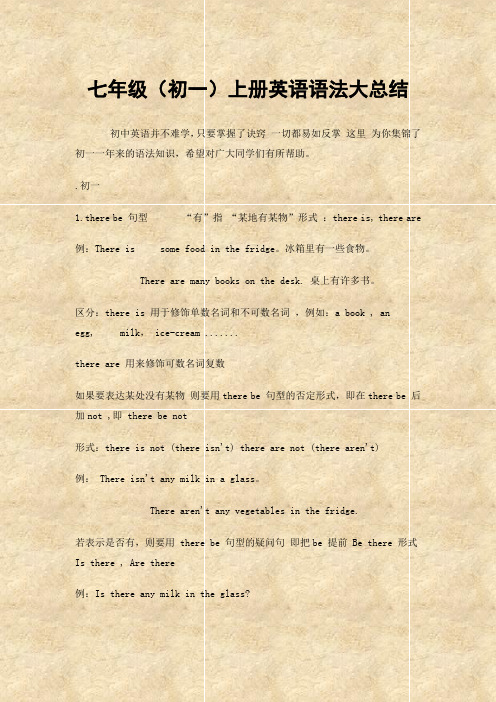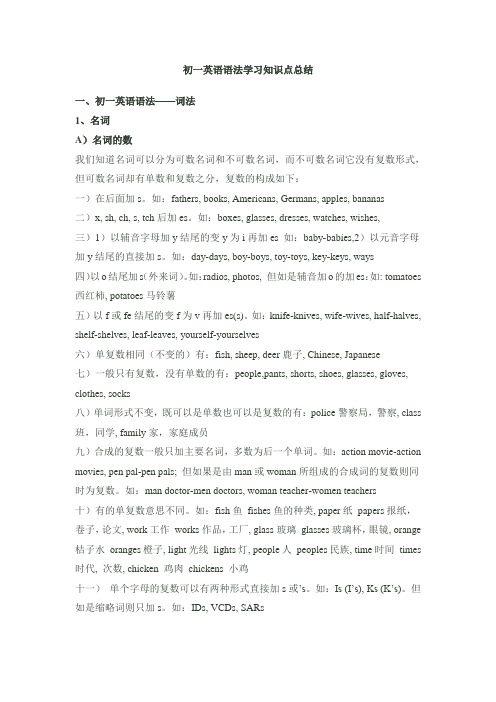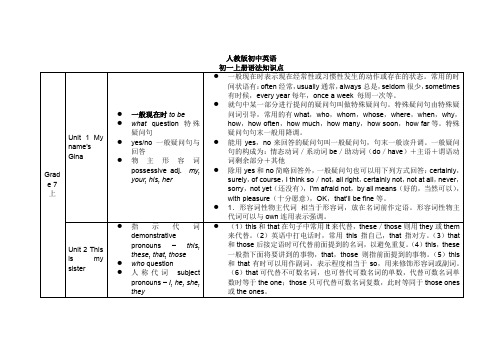初一英语上册各单元语法的知识点
(完整版)初一英语语法大全知识点

人教版七年级(上册)英语知识点第一块国际音标国际音标是一种工具,其作用是标记英语字母和单词的读音。
1、20个元音单元音:/i:/Ee、/з:/her /u:/do/I/it /ә/about /u/book/ɑ:/are //or /æ/any//us //off /e/at双元音://Ii //out //ear//Aa,//Oo //air//boy //sure2、28辅音:成对的清浊辅音:/p/map /t/it /k/book /f/off /θ/math /s/yes /b/club /d/dad /g/big /v/have /ð/this /z/zoo//fish //watch /tr/tree /ts/its//usually //orange /dr/dress /dz/beds其他辅音:/m/am /n/and //English /l/like/h/hello /r/red /w/what /j/yes3、国际音标拼读规则:辅见元,碰一碰。
/l/在前,发本音;音节后面卷下舌。
/p/、/t/、/k/、/tr /清辅音,/s/后读成浊辅音。
本块词汇:speak说讲start开始school学校 s trict严格的out外面club俱乐部usually通常 dress化妆about关于大约us我们her她的ear耳朵English英语sure当然可以air空气or或者any一些boy男孩orange橙子,桔子map地图tree树math数学 off离开watch观看手表do做like喜欢 beds床what什么hello喂是的red红色的yes是的 book书its它的 zoo动物园fish鱼dad爸爸big大的have有this这it它Starter unit1-3一、文化常识1、英语文化区域,熟人之间见面,常要互相问好。
早上用语Good morning !下午用语Good afternoon ! 晚上用语Good evening ! 例如:(1) Bob: Good morning , Helen !Helen : Good morning , Bob !(2) Bob : Good afternoon , Helen !Helen : Good afternoon , Bob ! ( 注意句子标点)(3) Bob : Good evening , Helen !Helen : Good evening , Bob !2、在轻松场合中,人们常用Hello 或者Hi 打招呼,但是两人用语要一致,不能一个人用Hello,另一个人用Hi 。
七年级(初一)上册英语语法大总结

七年级(初一)上册英语语法大总结初中英语并不难学,只要掌握了诀窍一切都易如反掌这里为你集锦了初一一年来的语法知识,希望对广大同学们有所帮助。
.初一1.there be 句型“有”指“某地有某物”形式:there is, there are 例:There is some food in the fridge。
冰箱里有一些食物。
There are many books on the desk. 桌上有许多书。
区分:there is 用于修饰单数名词和不可数名词,例如:a book , an egg, milk, ice-cream .......there are 用来修饰可数名词复数如果要表达某处没有某物则要用there be 句型的否定形式,即在there be 后加not ,即 there be not形式:there is not (there isn't) there are not (there aren't)例: There isn't any milk in a glass。
There aren't any vegetables in the fridge.若表示是否有,则要用 there be 句型的疑问句即把be 提前 Be there 形式Is there , Are there例:Is there any milk in the glass?Are there any vegetables in the fridge?注意:这里涉及some any 的用法 some 用于肯定句中,any 用于否定句和疑问句中。
但是在表示请求的疑问句中,是想要得到肯定答复的,要用some。
例:Would you like some milk?对于there be 疑问句的回答:肯定:Yes,there is\are. No,thereisn't\aren't.2.have\has got 有指某人有某物例:I have a dog.我有一只狗。
(完整版)初一英语语法学习知识点详细总结

初一英语语法学习知识点总结一、初一英语语法——词法1、名词A)名词的数我们知道名词可以分为可数名词和不可数名词,而不可数名词它没有复数形式,但可数名词却有单数和复数之分,复数的构成如下:一)在后面加s。
如:fathers, books, Americans, Germans, apples, bananas二)x, sh, ch, s, tch后加es。
如:boxes, glasses, dresses, watches, wishes,三)1)以辅音字母加y结尾的变y为i再加es 如:baby-babies,2)以元音字母加y结尾的直接加s。
如:day-days, boy-boys, toy-toys, key-keys, ways四)以o结尾加s(外来词)。
如:radios, photos, 但如是辅音加o的加es:如: tomatoes 西红柿, potatoes马铃薯五)以f或fe结尾的变f为v再加es(s)。
如:knife-knives, wife-wives, half-halves, shelf-shelves, leaf-leaves, yourself-yourselves六)单复数相同(不变的)有:fish, sheep, deer鹿子, Chinese, Japanese七)一般只有复数,没有单数的有:people,pants, shorts, shoes, glasses, gloves, clothes, socks八)单词形式不变,既可以是单数也可以是复数的有:police警察局,警察, class 班,同学, family家,家庭成员九)合成的复数一般只加主要名词,多数为后一个单词。
如:action movie-action movies, pen pal-pen pals; 但如果是由man或woman所组成的合成词的复数则同时为复数。
如:man doctor-men doctors, woman teacher-women teachers十)有的单复数意思不同。
人教版初中英语七年级上册语法知识点

have表示“有”时,其否定形式有两种:在其后直接加not,但常用于非正式用语中;利用助动词do加not。
②如果句子的谓语是实义动词,在谓语动词前加don't,doesn't,didn't。
③no,never,seldom,hardly,nobody,little,few,nothing等否定词也可以构成否定形式。
1.表示经常性或习惯性发生的动作2.表示现在存在的状态或情况3.表示正在发生的动作或存在的状态4.表示客观事实、真理和自然现象5.用于表示较固定的、按计划、规定将要发生的动作,但只限于begin,come,go,leave,arrive,stop,return,close,open,take,start,take,place等少数动作,6.用于if,unless,once,even if(即使)等引导的条件状语从句,when,before,until,as soon as,the moment(一……就)等引导的时间状语从句,no matter+wh-/-how-或wh-ever/however等引导的让步状语从句中,代替一般将来时
人教版初中英语
初一上册语法知识点
Grade 7
上
Unit 1 My name’s Gina
人教版初中英语七年级上册全册各单元知识点、语法归纳整理

人教版初中英语七年级上册全册各单元知识点、语法归纳整理She’s my sister.她是我的妹妹。
3.This is a picture of my family.这是我家人的一张照片。
4.In the first photo。
there’s my XXX.在第一张照片里,有我的爷爷。
5.This is my family tree.这是我的家谱。
6.What’s the name of your father?你父亲叫什么名字?7.Have a good day!过得愉快!重点语法1.名词所有格2.复数形式3.人称代词宾格4.指示代词this和these的用法5.介绍人物时的基本用语:This is …/These are…1.指示代词:this。
that。
these。
those - 这个,那个,这些,那些2.名词复数规则:1)一般情况下直接加s。
2)以s,x,sh,ch结尾的加es。
3)以辅音字母加y结尾的将y变i再加es。
4)以o结尾的加s或es。
(有生命+es物生命加s)5)以f/fe结尾的名词,先将f/fv变成v再加es。
3.人称代词:I。
he。
she。
it和they - 我,他,她,它,他们/她们/它们4.重点短语:Is this/that your。
- 这/那是你的……吗?Yes。
it is。
/ No。
it isn't。
- 是的,是它。
/ 不,不是。
XXX。
- 这些/那些是我的……Here are。
- 这里有……This/That is my。
- 这/那是我的……Have a good day。
- 祝你玩得愉快!Excuse me for interrupting。
but could I ask you a n?Thank you very much.Could you please speak in English?Do you enjoy playing computer games?Have you checked in the lost and found case to see if your item is there?Please call 685-6034 to reach me.I lost my school ID card and need to find it.I need a set of pencils for my art class.Key XXX structures:Is that your school bag?No。
初一上册英语知识点语法

初一上册英语知识点语法全文共四篇示例,供读者参考第一篇示例:初一上册英语知识点语法主要包括基本句型、时态、从句等内容。
在初一英语学习中,语法是学习英语的基础,掌握好语法知识对于提高英语水平至关重要。
下面将介绍初一上册英语知识点语法的一些重要内容。
一、基本句型1. 主谓结构:主语+谓语(动词)例如:He is a student.(他是一个学生。
)2. 主谓宾结构:主语+谓语(动词)+宾语例如:She likes apples.(她喜欢苹果。
)3. 主谓宾补结构:主语+谓语(动词)+宾语+宾语补语例如:She finds her book interesting.(她觉得她的书很有趣。
)4. 主谓宾宾结构:主语+谓语(动词)+宾语+宾语例如:He gave his sister a gift.(他给他的妹妹一份礼物。
)二、时态1. 一般现在时:表示经常性的动作或现阶段的情况例如:She reads books every day.(她每天都读书。
)2. 一般过去时:表示过去某个时间发生的动作或情况例如:I visited my grandparents last weekend.(我上周末去看望了我的祖父母。
)3. 一般将来时:表示将来某个时间要发生的动作或情况例如:They will go to the park tomorrow.(他们明天将去公园。
)以上是初一上册英语知识点语法的一些重要内容,通过学习这些知识点,可以帮助学生更好地理解和掌握英语语法,提高英语水平。
在学习英语语法的过程中,学生可以通过做练习题和阅读英语文章来加深对语法知识的理解,并且结合实际情境运用所学知识,提高语言表达能力。
希望以上内容对大家学习初一上册英语语法有所帮助。
【2000字】第二篇示例:初一上册英语知识点语法主要涵盖了基础的英语语法知识,包括名词、形容词、动词、介词等基本语法点。
在学习初一上册英语知识点语法时,学生需要掌握基本的语法规则,并且能够正确运用这些规则进行交流和表达。
七年级上册英语重点语法知识点
七年级上册英语重点语法知识点
以下是七年级上册英语的部分重点语法知识点:
1. 名词:掌握可数名词和不可数名词的基本概念,名词所有格的基本用法。
2. 代词:人称代词、物主代词、指示代词、不定代词(some、any、no、every)的基本用法。
3. 动词:动词的基本形式(现在分词、过去分词、动词不定式),动词的时态(现在进行时、现在时、一般过去时)。
4. 介词:常用介词的基本用法,如in、on、at等。
5. 形容词和副词:形容词和副词的基本用法,比较级和最高级的构成和用法。
6. 简单句:掌握简单句的基本句型,如主语+谓语、主语+谓语+宾语等。
7. 复合句:掌握宾语从句、定语从句的基本结构和使用方法。
以上是七年级上册英语的部分重点语法知识点,学生应通过大量的练习和阅读来巩固和掌握这些知识点。
七年级上册,英语,所有的语法
七年级上册,英语,所有的语法
以下是七年级上册英语的部分语法知识点:
1. 名词:名词是表示人、事物、地点等名称的词。
2. 形容词:形容词用来描述名词的性质、特征或状态。
形容词可以放在名词前面或后面。
3. be动词:be动词包括am, is, are三种形式,用来表示主语的状态或特征。
4. 助动词:助动词包括do, does, did三种形式,用来帮助主要动词表达时态、语态、否定等意义。
5. 介词:介词用来表示名词与其他词语之间的关系,如in, on, under等。
6. 连词:连词用来连接两个句子或从句,如and, but, or等。
7. 代词:代词是用来代替名词的词,如I, you, he等。
8. 副词:副词用来修饰动词、形容词或其他副词,表示程度、方式、时间等意义。
9. 动词:动词是表示动作或状态的词,如run, jump, like等。
10. 冠词:冠词用来限定名词,包括定冠词the和不定冠词a/an两种形式。
以上只是部分语法知识点,想要掌握更多语法知识,可以查阅教材或请教英语老师。
七年级英语语法知识点归纳总结上册
七年级英语语法知识点归纳总结上册一、名词。
1. 名词的分类。
- 专有名词:表示特定的人、地方、组织等,首字母大写,如China(中国),Tom(汤姆)。
- 普通名词:- 可数名词:有单复数形式,如book(书,单数),books(复数)。
- 不可数名词:没有复数形式,如water(水),milk(牛奶)。
2. 可数名词复数的变化规则。
- 一般情况加 -s,如pen - pens,desk - desks。
- 以s, x, ch, sh结尾的加 -es,如bus - buses,box - boxes,watch - watches,brush - brushes。
- 以辅音字母 + y结尾的,变y为i加 -es,如baby - babies。
- 以f或fe结尾的,变f或fe为v加 -es,如knife - knives,leaf - leaves(但也有一些直接加 -s的,如roof - roofs)。
- 不规则变化,如man - men,woman - women,child - children,foot - feet,tooth - teeth。
3. 名词所有格。
- 有生命的名词所有格:- 一般在名词后加's,如Tom's book(汤姆的书)。
- 以s结尾的复数名词,只加',如the students' classroom(学生们的教室)。
- 表示两者共有时,在后一个名词后加's,如Lucy and Lily's mother(露西和莉莉的妈妈);表示各自拥有时,在每个名词后加's,如Lucy's and Lily's bags (露西的包和莉莉的包)。
- 无生命的名词所有格,用“of+名词”结构,如the window of the room(房间的窗户)。
二、代词。
1. 人称代词。
- 主格:I(我),you(你/你们),he(他),she(她),it(它),we(我们),they(他们/她们/它们),在句中作主语,如I like English.(我喜欢英语)。
七年级上册英语语法及知识点
七年级上册英语语法及知识点1、动词be〔is,am,are〕的用法我〔I〕用am,你〔you〕用are,is跟着他〔he〕,她〔she〕,它〔it〕。
单数名词用is,复数名词全用are。
变否认,更简单,be 后not加上去。
变疑问,往前提,句末问号莫丢弃。
还有一条须留意,句首大写莫遗忘。
2、this,that和it用法〔1〕this和that是指示代词,it是人称代词。
〔2〕距离说话人近的人或物用this,距离说话人远的人或物用that。
如:This is a flower.这是一朵花。
〔近处〕That is a tree.那是一棵树。
〔远处〕〔3〕放在一起的两样东西,先说this,后说that。
如:This is a pen. That is a pencil.这是一支钢笔。
那是一支铅笔。
〔4〕向别人介绍某人时说This is…,不说That is…。
如: This is Helen. Helen, this is Tom.这是海伦,海伦,这是汤姆。
〔5〕This is不能缩写,而That is可以缩写。
如:This is a bike. That’s a car.这是一辆自行车。
那是一辆轿车。
〔6〕打电话时,介绍自己用this,询问对方用that。
如:—Hello! Is that Miss Green?喂,是格林小姐吗?—Yes, this is. Who’s that?是的,我是,你是谁?留意:虽然汉语中使用“我”和“你”,但英语中打电话时绝不行以说:I am…, Are you…?/Who are you?〔7〕在回答this或that作主语的疑问句时,要用it代替this 或that。
如:①—Is this a notebook?这是笔记本吗?—Yes, it is.是的,它是。
②—What’s that?那是什么?—It’s a kite.是只风筝。
3、these和those用法this, that, these和those是指示代词,these是this的复数形式,指时间,距离较近的或下面要提到的人或事;those是that 的复数形式,指时间、距离较远或前面已经提到过的人或事物。
- 1、下载文档前请自行甄别文档内容的完整性,平台不提供额外的编辑、内容补充、找答案等附加服务。
- 2、"仅部分预览"的文档,不可在线预览部分如存在完整性等问题,可反馈申请退款(可完整预览的文档不适用该条件!)。
- 3、如文档侵犯您的权益,请联系客服反馈,我们会尽快为您处理(人工客服工作时间:9:00-18:30)。
初一英语上册各单元知识点总结Unit 1 My name’s Gina【语法看点】语法探究一:常见的打招呼的问候语人际交往中,最常用的语言是打招呼的问候用语。
在不同的国家里,打招呼和问候的方式是不同的。
中国人喜欢用“吃了吗?”“你干什么去?”作为打招呼的开场白,而在欧美国家的人们是怎样打招呼或问候呢?1.熟人打招呼:—Hello! /Hi!—Hello! /Hi!2.不同时段的问候:—Good morning/afternoon/evening/night! (Morning!/Afternoon!/Evening!)—Good morning!/afternoon!/evening!3.熟人间关心的问好:—How are you?—Fine. thank you. And you?(I'm fine,thank you./I'm OK./Not bad.)4.晚上睡觉前的告别语:—Good night!晚安!—Good night!晚安!语法探究二:打电话用语我们经常打电话,但你知道怎样用英语给别人打电话吗?1.This is...(speaking).我是……2.Who is that? 你是准?或Is that...(speaking)? 你是……吗?3.May I speak to...,please? 我可以跟…说话吗?4.He's in (out).他在家(不在家)。
5.Can I take a message for you? 我可以为你捎信吗?6.Can I leave a message? 我可以留个信儿吗?7.Hold on,please.稍等。
Unit 2 This is my sister【语法看点】语法探究一:介绍和自我介绍“介绍和自我介绍”是新课程标准中的话题之一。
学会向外人介绍自己的家人是中学生日常用语常用的语言,也是中考中交际英语常考的内容。
下面就简单介绍一下。
(l)This is my,..这是我的……(2)That's my...那是我的……(3) Is this /that your...? 这/那是你的……吗?(4) These/ Those are... 这些/那些是……(5) —Who is she/he?她/他是谁?—She/He is my...她/他是我的…(6)—Who are they?他们是谁?—They are...他们是……语法探究二:人称代词和指示代词1.人称代词(1)概念:英语中代替具体的人或物的词叫人称代词,有第一、二、三人称及单复数、性别之分。
(2)用法:指代上文提到的不同人称的人或物。
如:Peter is a good boy. He is twelve.(3) be动词根据人称代词和数的变化而变化。
如:I'm Linda.He is Jim.2.指示代词(1)指示代词是指代前面的名词的词。
常见的有this,that,these,those等。
(2)用法:指示代词可以在句中作主语,宾语和定语。
如:This is a pencil.That boy is my new friend.♥提醒:this,these指代近处的人或事物;that,those指代远处的人或事物。
Unit 3 Is this your pencil?【语法看点】人称代词和物主代词语法探究一:人称代词(1)概念:表示“我”、“你”、“他”、“她”、“它”、“我们”、“你们”、“他们”的词,叫做人称代词。
人称代词有人称、数和格的变化,见下表:人称单数复数主格宾格主格宾格第一人称 I me we us第二人称 you you you you第三人称 he him they themshe herit it(2)用法:人称代词主格作主语 I am a teacher. You are a student.(3)人称代词宾格作宾语,表示动作行为的对象。
Give it to me. Let's go.语法探究二:物主代词(l)概念:表示所有关系的代词叫做物主代词,也可叫做代词所有格。
物主代词分形容词性物主代词和名词性物主代词两种,其人称和数的变化见下表。
数单数复数人称类别第一人称第二人称第三人称第一人称第二人称第三人称形容词性物主代词 my your his her its our your their名词性物主代词 mine yours his hers its ours yours theirs汉语我的你的他的她的它的我们的你们的他/她/它们的名词性物主代词=形容词性物主代词+名词。
其后不必加名词。
如:Is this your book? No,it isn't. It's hers(her book).Unit 4 Where’s my schoolbag?【语法看点】语法探究名词变复数小结可数名词有单数和复数两种形式。
名词单数变复数形式的部分规则如下:(1) 一般名词词尾加s。
如:pen→pens(2) 以o结尾的名词一般直接加~s。
如:radio→radios,photo → photos但有的以o结尾的有生命的名词要加~es。
如:tomato→ tomatoes(3) 以s,x,ch,sh结尾的名词变为复数时要加~es。
如:bus→buses, box→boxes, watch→watches(4) 以“辅音字母加y”结尾的名词变y为i加~es。
女口:dic tionary→dictionaries(5) 以“元音字母加y”结尾的直接加~s,如:boy→ boys,key→ keys(6) 以f或fe结尾的名词,一般情况下将f、fe变为v,再加~es。
如:leaf→ leaves, wife→wivesUnit 5 Do you have a soccer ball?【语法看点】语法探究:一般现在时1.定义表示现在经常性或习惯性的动作或状态;还用于个人的情况介绍。
2.用法(1)谓语动词为be。
①变否定句时,在am,is,are的后面加________即可;②变一般疑问句则要把________、________或________提前。
同时,把句号变成问号;③变特殊疑问句:用特殊疑问词替换画线部分,放在句首,同时把剩余的部分变成一般疑问句放在特殊疑问词的后面。
(2)谓语动词是实义动词。
①变否定句时,需要增加助动词________或________.当主语是第一人称I,we,第二人称you或第三人称复数时,助动词do变为________;当主语是第三人称单数时,助动词does变为________,同时,后面跟动词原形。
②变一般疑问句时,也要增加助动词放在句首,原来的动词变为动词原形。
③变特殊疑问句时,用特殊疑问词替换划线部分,置于句首,后面加—般疑问句。
Unit 6 Do you like bananas?语法探究:名词★分类:英语中的普通名词可以分为可数名词和不可数名词。
★可数名词复数的规则变化l) 一般情况,在名词词尾加____,如:apple→____________;book→____________ 。
2) 以s、x、sh、ch结尾的名词加____,如:glass→________ ,box→ ________ 。
3) 以辅音字母加y结尾的名词,变y为_____ 加_______ ,如cities,babies,enemies。
4) 以f或fe结尾的名词,多数变f或fe为v加es,如:wife→wives,leaf→leaves。
但有些词只加s,如:roofs,proofs,chiefs。
5)以o结尾的名词,多数加es,但一些外来词或词尾为两个元音字母的词加s。
如:tomato→________,zoo→zoos,photo→________。
6)不规则名词变化:foot→feet,tooth→teeth, child→children, man→men,woman→women, sheep→sheep, deer→deer,mouse→mice。
★名词变复数的读音:(口诀:清清浊浊元浊)1) 清辅音后读/s/,如:map→maps浊辅音和元音后读/ z /,如:bag→bags,car→cars2) 以s,sh,ch,x等结尾加es读/ iz /,如:bus→buses, watch→watches以ce,se,ze等结尾加s读/iz/,如:license→licenses, 以辅音字母+y结尾,变y为i再加es读/z/,如:baby→babiesUnit 7 How much are there socks ?语法探究:购物“购物”是初中新课程标准中规定的话题之一,也是中考常考的内容。
所以,学会“购物用语”对于我们学习英语非常重要。
常用的购物用语有:(1) Can I help you?= What can I do for you? 我能为您做些什么?(2) What color do you want? 您要什么颜色的?(3) What sizes do you have/want? 您有/想要多大尺寸的?(4) 一How much is it? 一It's…dollars/ yuan.这个多少钱?……美元/元。
(5) 一How much are they? 一They're... Dollars. 他们多少钱?他们……美元。
(6) What/How about…?……怎么样?(7) It's too expensive. 太贵了。
(8) It's cheap.很便宜。
(9) It/They look(s) nice. I'll take it/them. 看起来不错,我买了。
(10) Thanks a lot.非常感谢。
(11) You're welcome.不客气。
(12) Here you are.给你。
Unit 8 When is your birthday?【语法看点】语法探究一:生日话题“询问生日”是日常生活中常用到的话题,也是中考常考的内容。
所以,学会“询问生日…对于我们学习英语非常重要。
常用的询问生日用语有:—When is your birthday? 一It's…语法探究二:介词on,in,at的用法与时间名词连用时介词on,in,at的用法:at : 表示在某一时刻。
如: at six(o'clock)在六点钟,at halfpast rune在九点半,at three forty-five在三点四十五分in : 表示在某一段时间内,可能很长,也可能很短。
